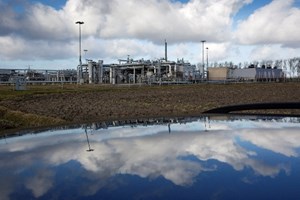Netherlands to end Groningen gas production by Oct 1
(Reuters) - Gas production at the Netherlands' Groningen field will end by Oct. 1, the government said on Friday, as it kept its promise to rapidly cease already minimal extraction to limit seismic risks in the region.

The field, operated by a joint venture of Shell and Exxon Mobil, still holds massive reserves of natural gas, but production has been almost completely wound down in the past years as tremors related to drilling caused widespread damage and mental anguish for people living nearby.
Production facilities will be closed permanently in 2024, the government said, but there will be an option to extract limited amounts of gas in extreme circumstances in the coming year.
"If it's very cold and we have problems at a storage we will be able to restart one or more facilities. But the decision is that production will be zero from Oct. 1," junior minister for Mining Hans Vijlbrief told reporters.
Vijlbrief added he had "no doubt" that the facilities would be dismantled after October 2024, as gas imports and the energy transition would ensure there would be sufficient gas for Dutch users by then.
Extraction at what once was one of Europe's largest natural gas fields, was limited to the minimum needed to keep it operational (around 3 billion cubic meters per year) in October last year, with the aim of shutting the field a year later or by 2024 at the latest.
That deadline was the result of an unusually strong earthquake in 2018, which made the government decide to rapidly end all production. A promise it kept despite mounting international pressure to deliver more gas to counter the energy crisis triggered by Russia's invasion of Ukraine.
But in the years before that decision both the government and the energy companies involved had gravely underestimated the risks of production for the people living in the province, a parliamentary inquiry concluded earlier this year.
Extraction was even increased to nearly 54 billion cubic meters (bcm) of gas in 2013 even though Groningen had been hit by the region's heaviest tremor on record a year before.
A gradual series of lowered caps on output was introduced only in the years after, as protests by residents and campaigners grew.
Discovered in 1959, production hit a peak of 88 bcm in 1976 and was still close to 30 bcm only six years ago.
Gas from the Groningen field is estimated to have delivered 363 billion euros ($395 billion) to the Dutch treasury since production started in the 1960s, laying the foundation for the country's welfare state.
Related News
Related News

- Shareholders’ Resolution: MOL to pay $668-MM dividend
- Credit Agricole says it will not fund two major LNG projects
- Aramco awards $7.7-B contracts to add 1.5 Bscfd of raw gas to Fadhili Gas Plant
- Japan's JERA suspends output at 4 gas-fired power plants to secure LNG stocks
- TotalEnergies: Papua LNG project requires 'more work' to reach final investment decision
- Technip Energies awarded a major LNG contract for the North Field South Project by QatarEnergy
- Shell publishes Energy Transition Strategy 2024
- QatarEnergy to charter 19 new LNG vessels expanding fleet further
- Aramco awards $7.7-B contracts to add 1.5 Bscfd of raw gas to Fadhili Gas Plant
- Mabanaft announces successful acquisition of WESTFA Energy GmbH



Comments